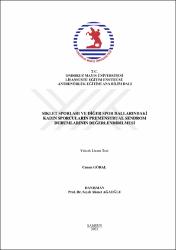Sıklet sporları ve diğer spor dallarındaki kadın sporcuların premenstrual sendrom durumlarının değerlendirilmesi
Künye
Göral, C. (2021). (Yüksek lisans tezi). Sıklet sporları ve diğer spor dallarındaki kadın sporcuların premenstrual sendrom durumlarının değerlendirilmesi. Ondokuz Mayıs Üniversitesi, Samsun.Özet
Amaç: Sıklet sporları ve diğer spor dallarındaki kadın sporcuların premenstrual sendrom durumlarının değerlendirilmesinin incelenmesidir. Materyal ve Metod: Bu çalışmanın evrenini Karadeniz bölgesindeki kadın sporcular oluşturmaktadır. Örneklem hacmini 467 kadın sporcu oluşturmaktadır. Katılımcıların 239 kişisi sıklet sporları 228 kişisi diğer spor dallarındaki kadın sporculardan oluşmaktadır. Verilerin toplanmasında "Kişisel Bilgi Formu" "Premenstrual Sendrom Ölçeği (PMSÖ)" kullanılmış olup, araştırma verilerin analizi SPSS (Statistical Package for Social Sciences) 21.0 istatistik analiz programı ile analiz edilmiştir. Bulgular: Araştırma katılımcılarının %57'sinin yaşları 18 ve altı yaştadır. Katılımcıların %77,3'ünün normal BKİ'ine sahip olduğu bulunmuştur. Sporcuların spor dalları dağılımı ise %51,2'sinin sıklet %48,8'inin diğer spor dalları olarak belirlenmiştir. Katılımcıların %29,6'sının 3-5 yıldır spor yaptığı belirlenmiştir. Katılımcıların %67'sinin ilk adet yaşının 13-16 yaş aralığı olduğu, %75,8'inin adetinin düzenli olduğu saptanmıştır. Araştırmaya katılan sporcuların spor dalları üzerine PMSÖ alt boyutları üzerine etkileri incelenmiş olup spor dallarının PMSÖ alt boyutları üzerine etkisinin olmadığı (p>0,05) belirlenmiştir. Evli sporcuların bekar sporculardan daha fazla şişkinliğe sahip olduğu (p<0,01), düzensiz adet dönemlerine sahip olanların daha fazla depresif duygulanım, anksiyete ve yorgunluğa sahip olduğu bulunmuştur. (p<0,05). Obez katılımcıların normal ve fazla kilolu katılımcılardan daha fazla anksiyeteye sahip olduğu belirlenirken, obez sporcuların zayıf sporculardan daha fazla şişkinliğe sahip olduğu belirlenmiştir (p<0,05). Spor yaşlarının PMSÖ alt boyutları olan yorgunluk, depresif düşünceler, iştah değişimleri, uyku değişimleri ve şişkinlik üzerine etkili olduğu (p<0,05) belirlenmiştir. Yaşadıkları yerlerin PMSÖ alt boyutu olan şişkinlik üzerine etkili olduğu (p<0,01) belirlenmiştir. Adetleri düzenli ve bazen düzensiz olan sporcuların, adetleri düzenli olmayan sporculardan daha fazla depresif duygu, anksiyete, sinirlilik, depresif düşünceler, iştah değişimleri ve uyku değişimleri davranışlarının gösterdiği (p<0,05) belirlenmiştir. Düzenli adet dönemlerine sahip olan sporcuların düzensiz ve bazen düzenli sporculardan daha fazla yorgun, ağrı ve şişkinlik hissettiği belirlenmiştir (p<0,01). Sonuç: Yaptığımız araştırmada kadın sporcuların spor dallarının PMSÖ alt boyutlarında bir etkisini olmadığı sonucuna varılmıştır. Anahtar sözcükler: Premenstrual sendrom, menstruasyon, kadın sporcu, sıklet. Aim: It is the examination of the evaluation of premenstrual syndrome status of female athletes in weight sports and other sports branches. Meterial and Method: The universe of this study consists of female athletes in the Black Sea region. The sample size consists of 467 female athletes. 239 of the participants consisted of weight sports and 228 of them were female athletes in other sports branches. "Personal Information Form and menstrual information form" and "Premenstrual Syndrome Scale (PMSS)" were used to collect the data, and the analysis of the research data was analyzed with the SPSS (Statistical Package for Social Sciences) 21.0 statistical analysis program. Results: The age of 57% of the research participants is 18 and under. It was found that 77.3% of the participants had normal BMI. The distribution of sports branches of the athletes was determined as the weight category of 51.2% and other sports branches of 48.8%. It was determined that 29.6% of the participants had been doing sports for 3-5 years. It was determined that 67% of the participants had their first menstrual period in the 13-16 age range, and 75.8% of them had regular periods. The effects of the athletes participating in the research on the sub-dimensions of the PMSS on the sports branches were examined and it was determined that the sports branches did not have an effect on the PMSS sub-dimensions (p>0.05). Married athletes had more bloating than single athletes (p<0.01), those with irregular menstrual periods had more depressive affect, anxiety and fatigue (p<0.05). It was determined that obese participants had more anxiety than normal and overweight participants (p<0.05), while obese athletes had more bloating than thin athletes (p<0.05). It was determined that sports age had an effect on fatigue, depressive thoughts, appetite changes, sleep changes and bloating, which are sub-dimensions of PMSS (p<0.05). It was determined that the place they lived had an effect on bloating, which is a sub-dimension of the PMSS (p<0.01). It was determined that the athletes with regular and sometimes irregular menses showed more depressive feelings, anxiety, nervousness, depressive thoughts, appetite changes and sleep changes behaviors than the athletes whose menstruation was not regular (p<0.05). It was determined that the athletes who have regular menstrual periods feel more tired, pain and swelling than irregular and sometimes regular athletes (p<0.01). Conclusion: In our study, it was concluded that the sports branches of female athletes did not have an effect on the sub-dimensions of the PMS scale. Key words: Premanstrual syndrome, menstruation, woman athlete, weight.
















